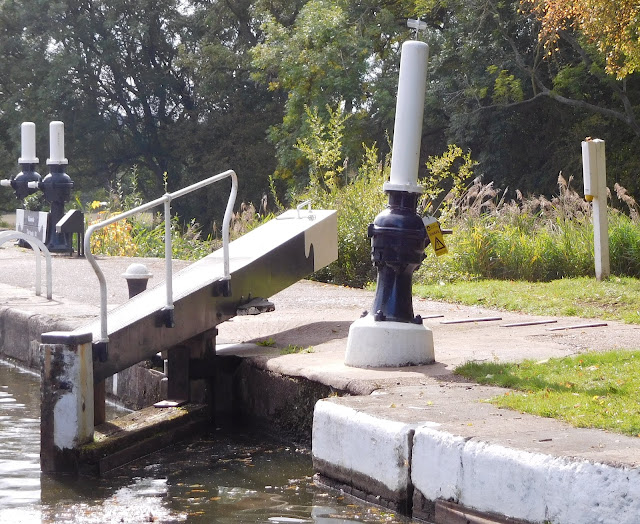Sunday 2nd October; Rowington to Catherine de Barnes
After a very quiet night (apart from the distant roar of the M40) we left at about 9.30. The towpath edge was very hard in spite of the rains so the mooring pins couldn’t be driven in as much as we would like, so it was fortunate that only two boats had passed us yesterday, and one this morning. The canal was in a cutting for a while, with the bank above the towpath gleaming with the shiny leaves of the hart’s-tongue fern.
There is a farm or smallholding along here which has goats, which love to stand or lie on the platforms in the field by the canal.
One was so still we wondered if it was stuffed! We passed the junction which leads to the Stratford canal at Kingswood Junction, and went on to moor past Kingswood Bridge so I could walk along to the village shop in Lapworth to get the paper and some milk. A single-hander went by as we were preparing to leave, very concerned that we knew the safe places to moor in Birmingham and reassured when we told him our plans. It’s easy cruising along here, wide with plenty of depth and concrete edges, and apart from that single-hander there were no boats on the move. Shortly before the Black Boy pub some new moorings have been constructed, though not yet connected to the canal. We assumed they belonged to the Black Buoy Cruising Club, opposite the pub.
Of course we wondered if they had originally been ‘Black Boy’, but no – this is what their website says;
The Black Buoy Cruising Club (BBCC) was formed in 1963. Obviously the close proximity of the Black Boy pub was the inspiration. The subtle change was probably made to demonstrate that the club was, and still is, a separate entity. Unfortunately it is sad that the identity of the person responsible for this clever pun has been lost in the obscurity of time.
The history of the club is interesting anyway with tales of their ingenuity in constructing clubhouses and cranes. And all this led me to research the origin of the pub name. And on their home page it says;
Pubs across England called The Black Boy are generally named after King Charles II. It was a nickname coined by his mother because of the darkness of his skin and eyes.
So the image of a be-wigged gentleman on the pub sign must be him. As we passed the boats outside the club a heron was stalking about on the roof of a boat. The end result could be worse than ducks I would think! We wondered why its beak was open.
It wasn’t quite midday as we approached Knowle locks, so we opted to go up before we stopped for lunch. With two volunteers we fair flew up them.
We knew all about the cross-winds at Knowle, where you should wait in one lock until the next is open for you, but with the volunteers locking ahead this wasn’t a problem. Apparently emptying a lock causes a whirlpool to form for a while below, so that can’t help! At the top Ken and Dave were busy fishing small branches out of the water. One top paddle is chained slightly open to maintain water levels in the long pound below the locks, and it has the effect of creating a slight flow down from Camp Hill locks.
The flow gently brings down all the logs
and debris that falls into the cut over the long miles through Yardley, Solihull
and so on. You can see the paddles for the side pond in the background - the lockies didn't think they'd be brought back into use.
We had to delay our lunch stop as there was a fishing match, and couldn’t moor until the towpath was too narrow to fish just before Kixley bridge. On the way we passed the now defunct Stephen Goldsborough Boats.
It was Stephen himself who told us
about the cross-winds at Knowle, way back when we had a share on Padworth. The
fishing match carried on for many more hundred yards. We were thanked for going past correctly (slowly, in the centre of the channel), and
several expressed the hope we would change their luck! A while later I spotted these interesting
plants along the towpath side. I have no
idea what they are. My best wild-flower book is at home. Stop Press: a blog reader has identified them as Aponogeton distachyos, using Google Lens which I will now use. Thank you Rita! So I looked it up - it's more commonly known as Water Hawthorn and you can buy it in this country for your garden pond. However in Ireland it is regarded as an invasive plant, so I will inform CRT (if I can remember exactly where it was).
And then at Copt Heath, where there are moored boats along the offside past the wharf, we saw the delightfully and amusingly named Butternut.
At Catherine de Barnes we went past
the rings and through the bridge to tie up on the Armco. We carefully positioned ourselves out of the acorn
drop zone – they were plopping into the
canal all around us though. Otherwise it was
quiet, apart from light traffic on the bridge – and planes coming into land
at Birmingham airport!
8¼ miles, 5 locks











aponogeton distachyos ! found on google lens, your wild-flower book friend
ReplyDeleteThank you Rita! I will edit the post
Delete